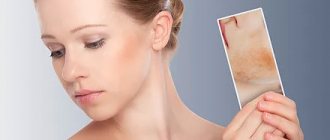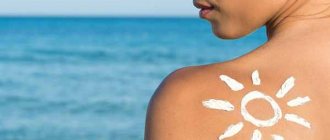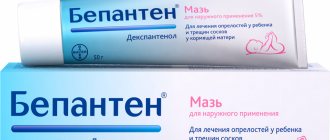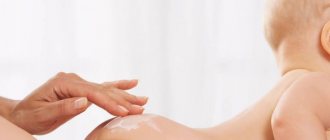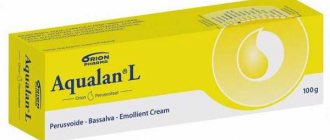Seborrhea develops in the so-called seborrheic zones - areas of the skin in which there are especially many sebaceous glands, about 400-600 per 1 cm2 1. These include:
- scalp;
- T-shaped area of the face (forehead, nasolabial folds, chin);
- the central part of the chest and the upper part of the back between the shoulder blades.
Seborrheic dermatitis is a chronic inflammatory disease that develops when the yeast-like fungus Malassezia furfur begins to actively multiply in the affected areas. About 3% of the population suffers from manifestations of this disease, and young people are more susceptible to them, among whom the number of patients increases to 5%.2
The disease is considered quite common. It manifests itself especially often in the first years of a child’s life, as well as in people after 40 years of age. This age-related feature of the occurrence of seborrheic dermatitis is explained by the fact that it is during these periods of a person’s life that the sebaceous glands on the body work with high intensity.
Causes of occurrence and development
The development of seborrhea and seborrheic dermatitis is based on dysfunction of the sebaceous glands of the skin, which manifests itself in the fact that the glands begin to produce either too little secretion (sebum) or too much, in addition, the composition and consistency of the secretion also changes. Excess secretions are mixed with dust, dead skin cells and can serve as a substrate for the active reproduction of opportunistic microorganisms, most often fungi of the genus Malassezia, which are normally present on the skin of 90% of the population3. The metabolic products of this pathogen cause skin irritation and its inflammatory reaction, manifested in the form of redness and the appearance of papules covered with greasy crusts.
Why does the functioning of the sebaceous glands malfunction? Doctors identify many factors that can play a role in dysfunction of the sebaceous glands. Among them:
- genetic predisposition;
- changes in hormonal levels (increased levels of progesterone and androgens, decreased levels of estrogen - therefore, the disorder is often found in men), including in infancy, puberty, pregnancy, and chronic diseases;
- decreased immunity due to chronic or infectious diseases, taking potent medications;
- a lot others.
The ducts of the sebaceous glands open into the mouth of the hair follicle, so with seborrhea and seborrheic dermatitis, not only the skin, but also the patient’s hair suffers.
The problem may worsen as a result of prolonged exposure to heat or due to increased sensitivity of the skin to external irritants. At the same time, seborrheic dermatitis in children and adults can be severe, regardless of the number of active fungi on the skin.
Reasons for appearance
Seborrhea in the ears may appear due to certain circumstances that are related to the health of the organs and systems of the human body. Among the causes of ear dermatitis, doctors identify:
- weakened immune system;
- improper metabolism;
- lack of vitamins, which often occurs in the spring;
- hormonal imbalances, especially during adolescence and pregnancy;
- the presence of chronic diseases of the gastrointestinal tract, kidneys and liver;
- frequent stress;
- genetic predisposition.
There is also contact dermatitis, which can occur due to the following factors:
- wearing jewelry, hearing aids or headphones made of metal that does not suit your skin;
- the use of chemical detergents and dyes that cause allergic reactions on the skin;
- drops for the treatment of otitis media;
- strong compression of hats made of synthetic materials towards the ears.
If ear dermatitis is not treated in time, it can develop into dermatosis.
Important point! Dermatosis is associated with the action of the fungus Malassezia furfur, which feeds on sebum secreted through the skin. The products of its vital activity are toxins that lead to the destruction of the epithelium. Seborrheic dermatosis often affects the ears.
How does seborrheic dermatitis manifest?
The disease affects certain parts of the human body. Typically this is:
- scalp skin;
- face;
- behind-the-ear areas;
- upper body (most often the area of the chest, shoulder blades);
- large skin folds on the body (for example, groin area, armpits).
Seborrheic dermatitis in adults and children manifests itself in the form of local redness and papules covered with greasy scales.
The disease can also be recognized at an early stage in adults by the appearance of a sign such as dandruff. As the situation worsens, the scalp gradually begins to become covered with red spots; later they can merge, forming lesions with characteristic peeling of the skin. In advanced cases, when oily crusts peel away from the surface of the skin, a moist secretion is discovered underneath. If you do not take any measures to treat seborrheic dermatitis, then this problem may be complicated by the addition of an infection.
In addition to external signs of seborrheic dermatitis, patients often complain of itchy skin. As a result of constant scratching of the inflammation, even greater tissue injury occurs with a high risk of further infection.
The disease not only causes serious discomfort, but also worsens a person’s quality of life as a whole, provokes self-doubt, makes it difficult to establish contacts with other people, and prevents them from building close relationships with the opposite sex.
Diagnostics
Oily seborrhea is distinguished by characteristic symptoms. Despite this, the process of diagnosing seborrhea includes a set of measures.
First, the doctor gets acquainted with the patient's medical history. This allows you to determine what led to seborrhea. After this, he collects and analyzes his life history. This makes it possible to find out against what factors the pathology of the epidermis of the head developed. Then a thorough examination of the affected segments of the head is carried out and a complete clinical picture of the course of seborrhea is compiled.
Also, before treatment, comprehensive instrumental diagnostics are carried out. The doctor examines both skin and hair.
The main methods of examining the head and hair include:
- Skin scrapings and microscopic examination of hair.
- X-ray of the abdominal cavity.
- Ultrasound of the thyroid gland.
- CT and MRI.
Patients also undergo laboratory diagnostics. It includes a general and biochemical blood test, as well as hormonal tests. If necessary, a gynecologist and andrologist, a neurologist, an endocrinologist and other specialized doctors are involved in the examination, diagnosis and further treatment.
Symptoms and forms/Types of seborrheic dermatitis
If we consider seborrhea and seborrheic dermatitis in children and adults, we can distinguish the following varieties:
- Dry seborrhea. With this nature of the disease, the sebaceous glands produce an insufficient amount of secretion. As a result, the skin does not receive enough moisturizing components, dries out, and microcracks appear on its surface. Typically, dry seborrhea occurs without the formation of acute inflammatory foci. Instead, the patient is concerned about the separation of dry dandruff particles. Most often, this form of the disease is observed in adolescent children.
- Oily seborrhea. The form differs from the previous one in that the sebaceous glands, on the contrary, work too actively and secrete a large amount of thick secretion. The substance glues together dead skin cells and is deposited on the hair, causing it to take on an unkempt appearance. The problem often affects young women.
- Combined type. It is characterized by the presence of signs of both dry and oily seborrhea. The disease develops in various parts of the body and therefore causes serious discomfort. In most cases, this form is diagnosed in males.
Depending on the location of the foci of inflammation, seborrheic dermatitis of the scalp, face and torso is distinguished.
The first sign of damage to the scalp is the appearance of dandruff. In this case, the scalp can be either excessively dry or oily, and the scales can range from silvery-white in mild cases to dense fatty crusts in severe cases.
In patients with seborrheic dermatitis of the scalp, over time, the hair becomes sparse, thin, brittle and often falls out.
Focal inflammation on the face is considered no less common. This form of the disease mainly affects teenagers and young people under the age of 25. The cause of seborrheic dermatitis in this case is the high activity of the sebaceous glands in the facial area. During puberty, they begin to work more actively, which can provoke the development of the disease. On the face, rashes are often symmetrical, located in the forehead, nasolabial folds, wings of the nose, and eyebrows.
At the initial stage, the disease manifests itself in limited areas of inflammation, the surface of which is covered with white-yellow scales. The rash is accompanied by itching and constantly peels off. As the disease progresses, areas of inflammation may merge. In some cases, inflammation is aggravated by the addition of a secondary infection.
Sometimes the inflammation spreads to the skin of the eyelids. This leads to the development of seborrheic blepharitis. It is characterized by the formation of severe swelling of the eyelids, redness of the eyes, and the formation of cracks in the delicate skin in this area. At the eyelash growth line, inflammatory foci gradually begin to form with a characteristic separation of small scales and crusts. Because of this, patients have to literally “pry” their eyes out in the morning, since the eyelids stick together so much.
On the torso, seborrheic dermatitis is usually localized in the area of the sternum and shoulder blades. The disease occurs with the formation of foci of inflammation with clear boundaries, covered with yellowish scales.
The severity of seborrheic dermatitis varies from mild to severe and depends on the extent of skin lesions, severity of inflammation and intensity of itching.
Infantile seborrheic dermatitis is one of the first skin diseases that a child encounters. It develops against the background of immature functions of the skin and sebaceous glands in infants and manifests itself in the form of fatty yellow crusts covering the head (the so-called “baby cap”), sometimes the area of the eyebrows and cheeks.
Mixed seborrhea
Mixed seborrhea has characteristics of dry and oily varieties. In particular, patients note that the skin on the face in the middle part is oily, and on the cheeks it is dry. Especially a lot of fat is released in the areas of the crown, chin, forehead, and nose. In other places the fat content is moderate or insufficient.
Doctors also note that a person may be bothered by dry dandruff and oily skin on the face.
Symptoms of mixed seborrhea:
- inflammatory process on the cheeks, scalp, chin, forehead, chest, nose;
- in the area of inflammation, the skin becomes rough;
- redness, itching;
- increased secretion of sebum on the forehead, but decreased secretion in other areas of the face;
- peeling in the area of increased activity of fat-secreting glands, yellowish or gray scales;
- peeling of dry areas of skin.
All the factors listed above as causes of other types of the disease can provoke mixed seborrhea. Most often the problem is associated with hormonal changes or disruptions. Heredity plays an important role. Stress and anxiety can also contribute to the growth of fungi.
Message sent!
Treatment of seborrheic dermatitis: basic approaches and methods
The tactics and treatment regimen for seborrheic skin dermatitis are selected by the doctor based on the form in which the disease occurs and in which area the inflammation is localized.
If the disease is mild, then this form is characterized by the presence of a small amount of dry or greasy scales, moderate redness of the skin, and occasional mild itching. With this course of the disease, the doctor, as a rule, limits himself to external therapy. For example, with mild damage to the scalp, or dandruff, the doctor may recommend the use of Skin-cap shampoo. Apply shampoo to damp hair, then massage the scalp until foam forms and rinse thoroughly. After this, you need to reapply the shampoo, leave for 5 minutes, and rinse thoroughly with plenty of water. Skin-cap shampoo can be used both for exacerbation of seborrheic dermatitis according to the scheme 2-3 times a week, and for the prevention of further relapses 1-2 times a week.
When the disease occurs in moderate to severe form, the symptoms of seborrheic dermatitis become more pronounced. At this stage, brighter red spots appear on the skin, sometimes noticeable swelling forms on the skin, and the surface is covered with dense gray-yellow crusts. All this occurs against the background of severe itching, which is present almost constantly. Due to discomfort, the patient cannot work fully, it is difficult for him to concentrate on anything, and often in the acute phase of the disease a person experiences problems with sleep.
In this case, there are also generally accepted recommendations on how to treat seborrheic dermatitis. The measures taken are comprehensive; patients may be prescribed hormonal medications. Treatment of seborrheic dermatitis is prescribed by a doctor, based on the severity of the disease and the individual characteristics of the patient. One of the non-hormonal drugs for the treatment of seborrheic dermatitis is the drug Skin-cap. It inhibits the activity of the Malassezia fungus and helps reduce signs of inflammation and also helps reduce flaking. Depending on the location of the inflammatory foci, Skin-cap shampoo, cream or aerosol may be prescribed. Skin-cap aerosol, for example, is suitable for treating the scalp, and the cream is convenient to apply to the face. The duration of treatment for an exacerbation varies, usually it takes from two weeks to 1 month to completely eliminate the symptoms of the disease.
The use of shampoo, cream and aerosol Skin-cap helps to significantly alleviate the condition of seborrheic dermatitis. The active ingredient of the drug Skin-cap has the following effects:
- provides anti-inflammatory effect;
- suppresses the growth and reproduction of pathogenic fungi, which are the main cause of exacerbation of the disease;
- inhibits the activity of bacteria that can increase inflammation.
The drug can be recommended to patients with any form of seborrheic dermatitis; treatment is possible for both adults and children over the age of one year. Products from the Skin-Cap line do not just eliminate the signs of the disease, they help keep the disease under control, preventing relapses.
Psoriasis and dandruff
Dandruff on the head appears not only due to the activity of the sebaceous glands and fungi. Sometimes scales on the hair occur with psoriasis. This is a common disease associated with heredity and the body's immune system. The disease is chronic, its therapy is designed to reduce symptoms.
Signs of psoriasis:
- the appearance of pink or red spots (occur not only on the head, but also on the arms, legs, and other parts of the body);
- gray scales on plaques;
- itching, sometimes pain.
An outbreak of this autoimmune disease can easily be confused with seborrhea. It is important to see a doctor on time, because the treatment of these ailments is very different.
Psoriasis appears between the ages of 15 and 35 years. Outbreaks of the disease can be caused by:
- poor nutrition;
- cold or dry air;
- stress.
The causative agent is not fungi, but the person’s own immunity, which attacks healthy cells, which causes active growth of the epidermis.
Therapy requires close supervision by a dermatologist. Both local and oral medications can be prescribed. Phototherapy, IV courses, and injections help relieve symptoms.
Features of SKIN-CAP release forms
The cream is quickly absorbed and softens and moisturizes the skin well and does not leave greasy marks on it. It is suitable for facial skin and affected surfaces that require moisturization.
The aerosol can be applied even to the scalp using a special nozzle, which is included in the kit, without touching the hair. It helps eliminate itching and dries out wet rashes.
Seborrhea shampoo effectively7 fights its manifestations on the scalp. Actively helps eliminate dandruff and itching, fights the root cause of the disease - pathogenic microorganisms. Ideal for preventing relapses.
Skin-cap shower gel is a cosmetic product that is indispensable for daily hygiene in cases where seborrhea affects the skin of the chest and back. It cleanses, soothes and moisturizes the skin, helps eliminate inflammation and restores the protective properties of the skin.
What does dandruff look like?
White flakes, clearly visible on dark clothes, are nothing more than dandruff. It consists of scaly particles of keratinized skin, appears at the roots of the hair, and then easily falls off. Most often, the disease is provoked by the activity of the Malassezia fungus. It is present on the skin of every person, but only under certain conditions does it begin to multiply and cause dandruff.
When the fungus on the scalp becomes active, a person feels itchy. Depending on the reasons that caused the spontaneous reproduction of microorganisms and the characteristics of the sebaceous glands, seborrhea (this is what the disease accompanied by peeling is called) is divided into dry, oily, and mixed. It can also manifest itself in other forms.
Prevention of seborrheic dermatitis
Patients with this disease need to know not only how to treat seborrheic dermatitis, but also learn the basic rules for preventing exacerbation of the disease. The main task in this case is to exclude those factors that can trigger the triggering of pathology development mechanisms.
Thus, as part of the prevention of seborrheic dermatitis, it is worth paying attention to several aspects:
- following a certain diet;
- compliance with personal hygiene rules;
- quality skin care;
- maintaining an active and healthy lifestyle;
- timely treatment of concomitant diseases.
Diet for dermatitis
The diet for seborrheic dermatitis should be based on healthy foods containing a small amount of fat. These include a variety of cereals, lean meats and fish, and always fresh vegetables and fruits.
It is important not only to eat well and properly, but also to follow some recommendations for cooking. Thus, the most preferred options for heat treatment of products are boiling, baking, steaming or grilling without adding oil.
Maintaining personal hygiene
Patients with seborrheic dermatitis are recommended to injure the inflammation as little as possible. Personal hygiene rules include cleansing the skin twice a day using special products with a low pH. To cleanse the skin, it is prohibited to use aggressive agents such as laundry or tar soap.
General recommendations for maintaining personal hygiene:
- the use of washcloths or sponges with hard fibers is excluded;
- For a while, you should avoid cleansing your skin with scrubs and peels containing abrasive particles and aggressive chemical compounds;
- During water procedures, it is recommended to use dechlorinated water; for this purpose, it is recommended to first settle or filter it;
- the duration of water procedures should be reduced to 10-15 minutes;
- when choosing shower products, choose products without dyes and fragrances, with a low pH;
- use towels with soft bristles, and it is better to blot your skin with them rather than rub them;
- to reduce the likelihood of skin injury when combing, try to cut your nails as short as possible;
- Avoid using other people's personal hygiene items.
Skin care rules
Skin care prone to symptoms of seborrheic dermatitis is primarily focused on normalizing the functions of the sebaceous glands. It is important not only to reduce sebum production, but also to ensure skin hydration.
General care recommendations:
- Try to reduce the use of comedogenic makeup, as it can cause clogged pores.
- Use care products that do not contain alcohol. It irritates the skin, dries it out, causing the sebaceous glands to work more actively.
- For care, choose special cosmetic products designed for seborrheic skin.
Ear dermatitis in an adult
Ear dermatitis is common in older people, and in adults it is usually contact eczema or bacterial inflammation. Contact eczema is caused by metal jewelry, glasses, headphones, earplugs, as well as hair dye, some care products, and perfume, which is sometimes applied to the earlobes. Bacteria can enter the outer ear canal through bathing, swimming in pools and especially in open water, and when the skin inside the ear is damaged, such as by scratching or cleaning the ears.



